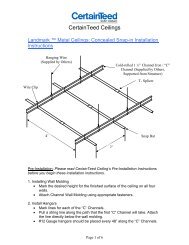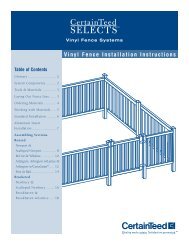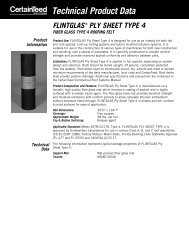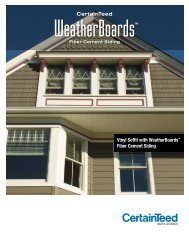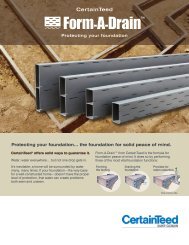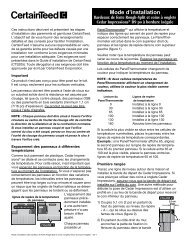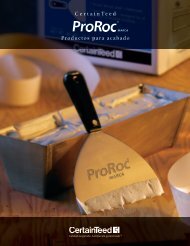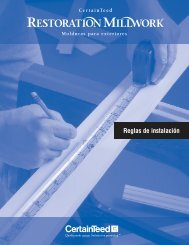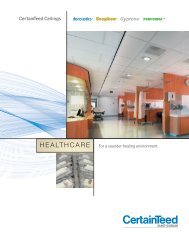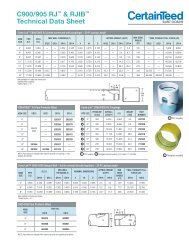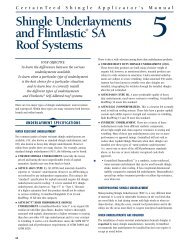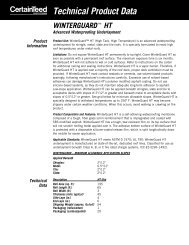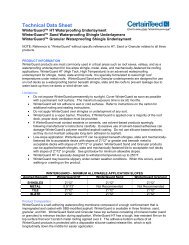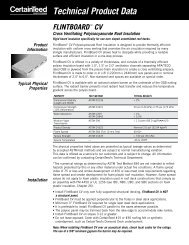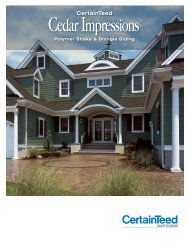Installation Manual - CertainTeed
Installation Manual - CertainTeed
Installation Manual - CertainTeed
Create successful ePaper yourself
Turn your PDF publications into a flip-book with our unique Google optimized e-Paper software.
<strong>CertainTeed</strong> WeatherBoards Fiber Cement Siding <strong>Installation</strong> <strong>Manual</strong><br />
Surface Preparation<br />
The degree and type of required surface preparation<br />
depends on the condition of the old finish. Loose paint<br />
material should be removed by sanding and scraping.<br />
The surface should be cleaned before painting as<br />
described in the Washing section. If the old surface is<br />
sound, re-priming is typically not necessary.<br />
Use only top quality, exterior type, acrylic latex primers.<br />
Confirm the compatibility of your primer and finish coats<br />
with your paint supplier. <strong>CertainTeed</strong> recommends l00%<br />
acrylic latex primer and paint system, using only the<br />
highest grade paints. Check with your paint supplier for<br />
compatibility with fiber cement siding.<br />
Efflorescence<br />
What Is It?<br />
Efflorescence is a naturally occurring, white, powdery<br />
deposit that can appear on cement-based building<br />
materials (including bricks, cement walls, grout, and fiber<br />
cement). It is the result of a process in which moisture<br />
draws salt crystals to the surface, evaporates, and<br />
leaves a chalky substance behind.<br />
Efflorescence occurs when all three of the following<br />
conditions exist:<br />
1. Water-soluble salts are present in the building material.<br />
2. There is enough moisture in the wall to turn the salts<br />
into a soluble solution.<br />
3. There is a path for the soluble salts to get to<br />
the surface.<br />
Efflorescence may also be a sign of water intrusion<br />
behind the siding. Make certain that all openings are<br />
properly flashed and there is no water intrusion due to<br />
over-driven nails.<br />
58<br />
What Can Be Done about It?<br />
While some efflorescence may weather away naturally on<br />
its own, it is best to take steps to treat it using one of the<br />
methods described.<br />
Vinegar and Water Solution<br />
Efflorescence can be removed with a dilute solution of<br />
household white vinegar and water. The dilution ratio is<br />
20 to 50% vinegar in water by volume. For most cases<br />
of efflorescence, a 25% solution works well.<br />
For best results, follow these cleaning instructions:<br />
1. Spray all plants and vegetation with water before<br />
and after application of the vinegar/water solution.<br />
2. Protect areas that will not be cleaned.<br />
3. Wet the surfaces to be cleaned with water and let<br />
stand for 5 to 10 minutes. Flood the entire surface<br />
area to be cleaned with vinegar and water solution.<br />
4. Allow the solution to sit on the surface for 10 minutes.<br />
5. Rinse the treated area with water from the top down.<br />
For extra tough efflorescence, a second application or<br />
light scrubbing may be required. Use a soft bristled brush<br />
or sponge and lightly scrub the area. Do not aggressively<br />
scrub as this may damage the surface of the painted<br />
product. Rinse thoroughly with water and allow the area<br />
to air dry. If necessary, repeat these steps until you’ve<br />
reached the desired outcome.<br />
House Washes<br />
Commercially produced house wash solutions that may<br />
also be used to safely treat efflorescence are available.<br />
Follow the manufacturer’s instructions to ensure that the<br />
product is suitable for use on fiber cement.<br />
Complete product details, including technical information,<br />
installation guidelines and warranties, are available at<br />
certainteed.com or at 800-233-8990.



